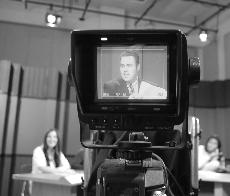It might not register with them each time the “On-Air” sign lights up, but students in the School of Mass Communication are recording history this semester.
Following the decision to terminate several mass communication sequences through the “Pathways” plan, administrators pulled the plug on both the broadcast journalism and broadcast production sequences and Loyola’s closed-circuit TV station. In the coming weeks, the studios on the fourth floor of the Communications/Music Complex – home to WLDC-TV news – will fall dark.
“They are the best class ever. They are the end of an era,” said mass communication instructor Lisa Martin of her students that broadcast the campus news program.
Martin teaches TV News Studio, where students create the 15-minute-long program. As a Loyola broadcast alumna, she has worked in newsrooms across the country and is instructing the last class of Loyola broadcast students that will also continue to fill openings at TV stations in a large number.
“Every show they create is special, since nobody knows if they (the broadcasts) will happen ever again,” Martin said.
After Hurricane Katrina, when the future of the city and the university was uncertain, broadcast students returned to the university to learn the future of their program was in jeopardy with the proposed “Pathways” plan. The Board of Trustees approved the plan – broadcast cuts included – last May.
Students in the sequence believe Loyola is losing a part of what sets the university apart from its peer institutions and forgetting part of its history that includes affiliations with local broadcast powerhouse WWL-TV, which Loyola founded and owned until the early 1990s.
“I feel that it is important for people to realize what Loyola is losing. Most people never realized it was a program here. I had a great time while learning a precious skill,” mass communication senior Marcy Craig said. Craig is in Martin’s TV News Studio class and is an aspiring television news reporter.
Students who have produced WLDC-TV have a history of performing under difficult and even sticky situations since the station’s inception in the 1960s.
The stations’ call letters, WLDC, stand for Loyola Danna Center, because their original studio was located in the basement of the building underneath the Orleans Room kitchen. (Some individuals on campus say the call letters stand for Loyola Department of Communications.)
“Sometimes the kitchen’s grease trap would overflow into the studio, and the place was filled with it and all sorts of other disgusting things,” said Larry Lorenz, interim dean of the College of Social Sciences and one-time chairman of the former Department of Communications.
Martin’s class now produces the newscast with modern TV production technology. But despite the clean and safe environment, Martin has warned her class of the hazards of working in a newsroom.
Her syllabus for TV News Studio reads, “Newsrooms can be explosive environments. Feelings get hurt. Keep your temper in check and keep your tears to yourself. None of us wants to see either. You have to work together often and in tight quarters.” Her class has taken the words to heart as they understand that their show must go on while it still can.
Kathy Martinez can be reached at kpmartin@loyno.edu.






